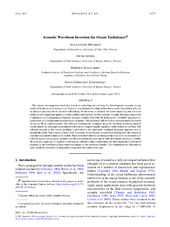Acoustic waveform inversion for ocean turbulence
Peer reviewed, Journal article
Published version

Åpne
Permanent lenke
https://hdl.handle.net/1956/19282Utgivelsesdato
2017Metadata
Vis full innførselSamlinger
- Department of Earth Science [1050]
Originalversjon
https://doi.org/10.1175/jpo-d-16-0236.1Sammendrag
The seismic oceanography method is based on extracting and stacking the low-frequency acoustic energy scattered by the ocean heterogeneity. However, a good understanding on how this acoustic wavefield is affected by physical processes in the ocean is still lacking. In this work an acoustic waveform modeling and inversion method is developed and applied to both synthetic and real data. In the synthetic example, the temperature field is simulated as a homogeneous Gaussian isotropic random field with the Kolmogorov–Obukhov spectrum superimposed on a background stratified ocean structure. The presented full waveform inversion method is based on the ray-Born approximation. The synthetic seismograms computed using the ray-Born scattering method closely match the seismograms produced with a more computationally expensive finite-difference method. The efficient solution to the inverse problem is provided by the multiscale nonlinear inversion approach that is specifically stable with respect to noise. Full waveform inversion tests are performed using both the stationary and time-dependent sound speed models. These tests show that the method provides a reliable reconstruction of both the spatial sound speed variation and the theoretical spectrum due to fully developed turbulence. Finally, the inversion approach is applied to real seismic reflection data to determine the heterogeneous sound speed structure at the west Barents Sea continental margin in the northeast Atlantic. The obtained model illustrates in more detail the processes of diapycnal mixing near the continental slope.